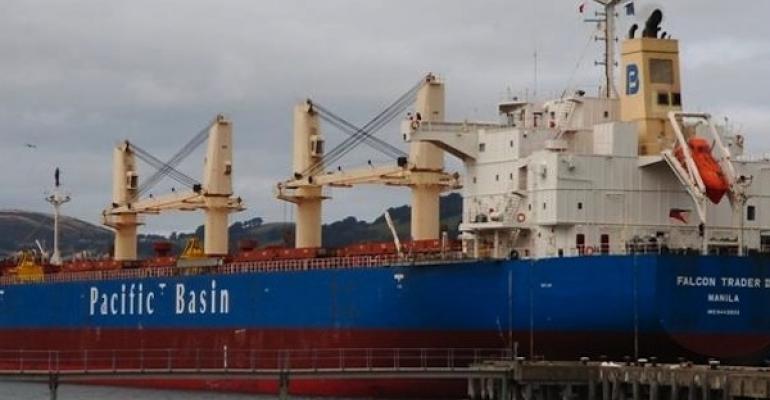“All things considered, we continue to believe that any negative impact the protectionist actions have on the dry bulk trade will be largely outweighed by positive dry bulk supply fundamentals and continued global dry bulk trade growth overall,” said ceo Mats Berglund at the minor bulks specialist’s first half results.
Better rates and the company’s continued outperformance of the market turned it solidly back to the black with a $30.8m net profit from a $12.0m loss previously. Pacific Basin’s Handysize and Supramax net daily TCE earnings of $9,750 and $11,730 were up 23% and 32% year-on-year, and outperformed the Baltic Handysize and Supramax spot market indices by 19% and 11% respectively.
Meanwhile, the company had current coverage of 54% of Handysize days for the second half at $9,610 and 67% of Supramax days at $11,010 per day net.
Pacific Basin said key positive drivers in the first half included 3% and 4% increases in Brazilian export volumes and US export sales of grain and other agricultural products, supported by record soybean volumes from Brazil and corn sales from the US.
Meanwhile, Pacific demand benefited from increased trade in bauxite, nickel ore, copper concentrate, forestry products and other minor bulks, the company said.
On the key China market, Pacific Basin noted that despite 7% growth in steel output to all-time high levels, Chinese steel exports declined 14% primarily due to strong domestic demand and high prices.
Read more: Dry bulk 'largely out of the woods'; Pacific Basin chairman Turnbull
Meanwhile Chinese imports of minor bulks grew 8% (excluding bauxite and nickel ore for which data is not yet available). But indications are for strong growth full-year growth in these commodities, helped by Indonesia coming back to exporting large volumes.
“US-related trade dispute actions to date impact only a small fraction of the trades in which Pacific Basin is engaged,” Berglund said, adding that total US soybean exports to China in 2017 represented only about 0.6% of total dry bulk seaborne trade.
He pointed out that commodity trading patterns typically tend to shift rather than stop due to the effects of trade tariffs. Berglund warned however that “the trade conflict between the US and its key trading partners might get resolved but may also escalate. This uncertainty weakens sentiment which could undermine trade, and a global trade war could impact global GDP and dry bulk demand”.
Looking ahead Berglund said: “Despite on-going trade tensions, we remain cautiously optimistic for a continued market recovery, although with some volatility along the way.”
Citing Clarksons Research full-year forecasts, he also noted that minor bulk tonne-mile demand is estimated to expand by 4% as longer average distances are forecast to supplement volume growth by an additional 0.7%. Meanwhile, due to the declining orderbook, newbuilding deliveries in the first half of 2018 reduced to about 15.4m dwt, comprising 1.9% of existing dry bulk capacity, the lowest level since 1988 while scrapping dropped to just 0.3% of existing capacity due to the much improved freight market conditions.
Looking better for the future, new ship ordering was also limited, with most newbuildings among large bulkers, Berglund said and noted that Handysize and Supramax new ship ordering is down to an historic low of around 1%.
Read More: Pacific Basin weighs in against scrubbers
On the Sulphur cap issue, Pacific Basin has changed its position somewhat from earlier in the year when Berglund specifically said scrubbers were not an effective solution and called for a mandate to use low Sulphur fuel instead.
Apparently conceding to an inability to get this mandate, Berglund said the company is now assessing both options. “We lobbied for a mandate for everyone to burn low sulphur fuel as this would be an environmentally more effective solution and supporting a level playing field, lower speeds and lower emissions (including CO2). However, it appears there is now no scope to change the rules, and some owners of larger vessels (including some Supramax owners) are planning to install scrubbers,” he said.
“We continue to assess both the low sulphur fuel and the scrubber options, but continue to believe that the vast majority of the dry bulk fleet (especially smaller ships like Handysize vessels) will comply by using low sulphur fuel,” Berglund said.
Looking on the bright side however, he said that continuing regulatory uncertainty would complicate newbuilding decisions and in turn cap supply.
“We believe that, combined, these regulations will over time encourage scrapping of poor quality ships and be positive for the supply-demand balance and benefit larger, stronger companies with high quality fleets that are better positioned to adapt and to cope practically and financially with both compliance and new technology,” Berglund concluded.
Copyright © 2024. All rights reserved. Seatrade, a trading name of Informa Markets (UK) Limited. Add Seatrade Maritime News to your Google News feed.


